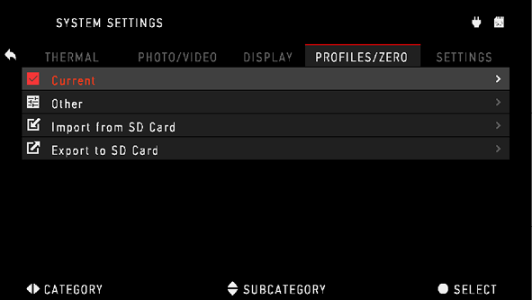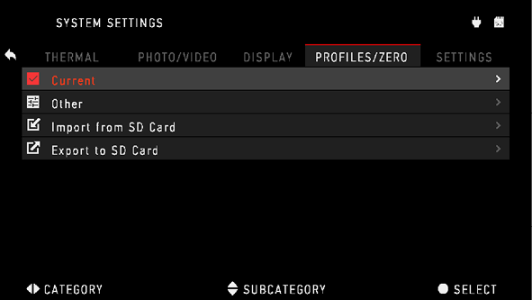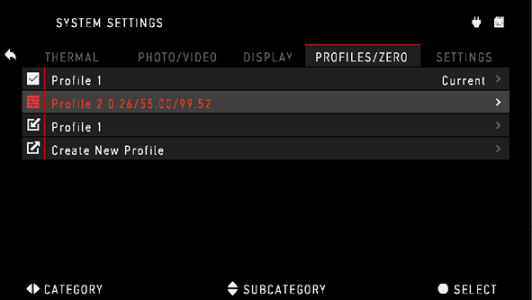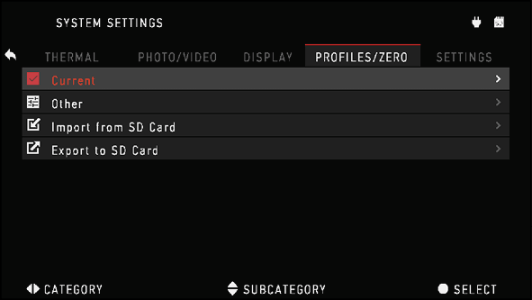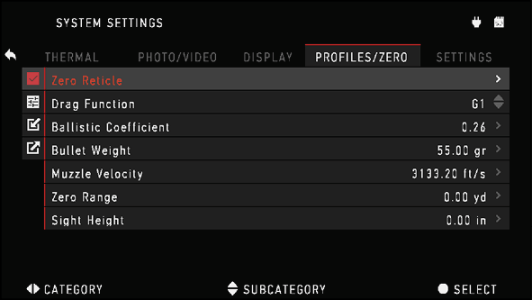Preparing the Device
![]() Download this manual (.PDF, 2.51 Mb)
Download this manual (.PDF, 2.51 Mb)
Unpacking
The following steps must be performed prior to use:
- Open packaging box, remove ThOR-HD and check the contents.
- ATN Help Card
- ATN ThOR-HD
- Battery Lifetime Information and Power Kit Card
- FB Group and ATN Forum Card
- Firmware Update and Review Card
- Black Nylon Case
- ThOR-HD Manual
- ThOR-HD Quick Start Guide Card
- Make sure that nothing is missing.
- Inspect the device for damage to optical surfaces, body, eyecups, operation buttons, etc.
- Ensure that all optical surfaces are clean and ready for use.
NOTE:
If any accessories are missing or broken contact ATN’s Customer Service.

Installation of Batteries
The ThOR-HD will operate on four AA-type Lithium batteries.
NOTE:
We highly recommend using lithium AA batteries. They will provide much longer battery life. Use only 1.5 V batteries.
Install batteries as follows:
- Remove the battery cap by unscrewing it counter clockwise.
- Insert batteries as shown.
- Return the battery cap into the housing socket (screw clockwise until finger tight). Make sure that the Red O-Ring is not visible to prevent shut off issues due to recoil, but also Do not over-tighten!
You want to ensure you can unscrew the cap next time you replace batteries.

NOTE:
Make sure that the device is turned off before changing source of energy (batteries or USB in power supply mode).
MicroSD, USB and HDMI Ports
The device is equipped with microSD, micro USB and micro HDMI ports and can be found under the cap near the battery block (marked with appropriate icons on the cap).

NOTE:
Make sure the device is turned off before inserting the microSD card into the slot.
To Use:
- Push it in using the same thin object.
- When it pops up a few millimeters, it can be pulled with your fingers or tweezers.
NOTE:
If you are going to record video, the microSD Card should be a Class 10 (10 Mb/s) or faster and have capacity from 4 to 64 Gb.
To remove the microSD Card from the slot, push it in using the same thin object. When it pops up a few millimeters, it can be pulled with your fingers or tweezers.
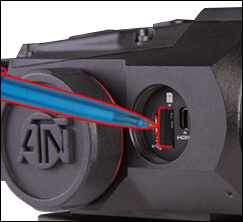
NOTE:
If you are going to record video the microSD Card should be a Class 10 (10 Mb/sec) or faster and have capacity from 4 to 64 Gb.
How to Update the Firmware
Before operating your device, update the firmware to the latest version.
To receive a notification of new firmware updates, please register your device on our website (you’ll receive an email letting you know when the new firmware becomes available).
To update the new firmware you will need a microSD card and batteries that are fully charged.
NOTE:
In the event of a power failure during an update. The device may crash, corrupting its system files. It will need to be sent back to the ATN factory for service. DO NOT USE an additional source of power during firmware update!
Update the new firmware as follows:
- Download the ***.bin file from https://www.atncorp.com/firmware (You may need to create an account, if you didn’t create it earlier) and copy to your microSD Card — root directory.
- Insert the card into the device.
- Turn ON the device.
- In the “Firmware Update” dialog box select “Yes” to start the update.
- When the update counter reaches “100%” the device will automatically restart.
- Once the device is powered up it will enter self configuration mode.
- After completing it will automatically restart and will be ready for use.
- Motion Sensing platform will be configured when first turned on.
- Once the Firmware update completes, please do a factory reset before using the product.
- Please remember to delete the Firmware File off of the microSD card after all steps are completed.
NOTE:
If the device does not restart within 30 seconds, remove and re-insert the batteries, and again power-up the device. Once the device has been updated you will need to either format the card or delete the update file manually. In the event you do not perform the previous actions, the system will ask you if you wish to update the device every time you turn it on.

ON / OFF
To TURN ON the device, press and hold the POWER Button until you see the ATN splash screen.
To TURN OFF the device, press and hold the POWER Button until the “Shut down the device?” appears in the dialog box. Choose “Yes” to turn off the unit.

NOTE:
Upon startup you must perform a NUC. Please refer to page 26 to learn how to perform the NUC process correctly.
Using Keypad
The KEYPAD is programmed to be used in two different ways:
- Short and Quick Taps — used for most functions and to get around the menu;
- Press and Hold — designed to be used in the following situations — ON/OFF, ZOOM and SHORTCUT MENU.
NOTE:
Using LEFT or RIGHT buttons in the Menu will allow you to quickly choose Exit Shortcut from any position.

Focusing
DIOPTER ADJUSTMENT
Look through the eyepiece, focusing on the reticle on the screen, and rotate the Diopter Adjustment Ring until optimal sharpness is achieved. Do not take the rubber cap off the objective lens.

NOTE:
You should not have to re-adjust the Diopter Adjustment unless another user, with different vision needs, uses the scope.
FOCUS ADJUSTMENT
Remove the cap from the objective lens and rotate the focus adjustment ring, as necessary, to achieve the proper focus at various distances.
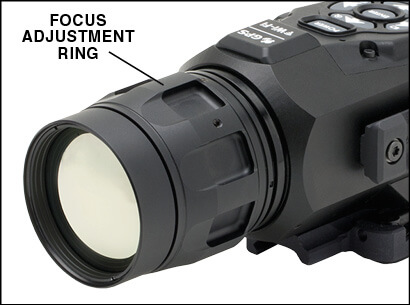
Mounting your scope

Secure the ThOR-HD to your Picatinny Rail using the Quick Release Mount as shown above. However, the ThOR-HD 384 1.25-5x has a different mount — with two fixing screws.
- Slightly loosen the fixing screws on the 7/8˝ weaver mount built into the scope.
- Place the scope on the weaver rail of the firearm.
- Tighten the fixing screws.
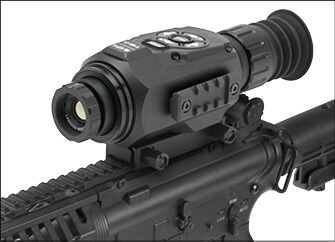
NOTE:
Fixing screws may need to be tightened after continuous shooting. ATN recommends using “Loctite” to ensure screws do not loosen up during shooting.
Compass Calibration
When the compass needs to be calibrated, the word “CAL” appears instead of the Compass Scale. To calibrate, rotate the three axis points as pictured on the left, on the device.

NOTE:
After calibrating the device, please remember that the compass will work best when holding the ThOR-HD parallel to the ground.
Other possible abbreviations:
- ERR — an error was detected, you may need to restart the device or recalibrate the compass;
- SMF —your device is under a strong magnetic field, move away from the source;
- UPD — your firmware needs to be updated.
Interface
Home Screen
The Homescreen will first appear when you switch on the device. It consists of Scales, Status Bar icons and different Information Widgets.
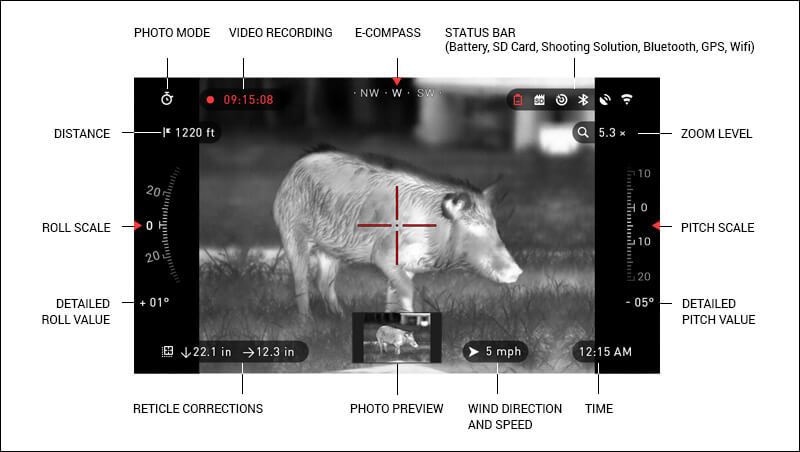
SCALES
- The E-Compass Scale shows yaw angle based on e-Magnetometer data.
- Roll Scale shows the rifles cant based on internal 3D Gyroscope.
- Pitch Scale shows rifle inclination based on internal 3D Gyroscope.
STATUS BAR
Information displayed will only be about the current state of system.
Inactive icons become invisible, only the important information will show at the moment:
- Battery — appears when energy level is low;
- SD Card — shows the presence of memory card;
- Ballistic Calculator, Bluetooth, GPS and WiFi — shows when a function is enabled.
WIDGETS
There are interface elements that provide quick access to useful information. There are several types of widgets:
- Icons without value are used for mode display (Photo and Video Modes).
- Only numerical value (Detailed Roll and Pitch Values).
- Icons with a numerical value: Zoom, Time, Reticle Correction, Distance, Video Recording.
- Photo Preview appears in the bottom of the Homescreen, after the photo was taken.

Display widgets can be viewed in the System Settings.
To enter System Settings, click on the ENTER button  from Homescreen and access the Shortcut Carousel.
from Homescreen and access the Shortcut Carousel.
Select the wrench icon with RIGHT or LEFT buttons  and push ENTER button
and push ENTER button  to enter the menu.
to enter the menu.
Select Display tab with RIGHT button  and choose subcategory Display Widgets with DOWN button
and choose subcategory Display Widgets with DOWN button  .
.

Main Operations

ZOOM LEVEL
- Zoom IN and OUT by pressing and holding the UP or DOWN button
 on the keypad.
on the keypad. - Current Zoom Level is displayed in the Zoom widget on the Homescreen.
NOTE:
You will need to configure the lens option in the pop-up window before zooming when the device is activated for the first time.
Your reticle can be offset from the center point of the screen while using Ballistic Calculator. During the Zoom In Action, it will move to the center.

TAKING PHOTOS
Press the LEFT button  to TAKE A PHOTO.
to TAKE A PHOTO.
Depending on the selected mode, you will take one or several photos. You can choose from various photo modes in the System Settings.

VIDEO RECORDING
By pressing the RIGHT button  , you will be able to RECORD VIDEO (if you use Normal Mode) or START RAV (if Recoil Activated Video mode is on).
, you will be able to RECORD VIDEO (if you use Normal Mode) or START RAV (if Recoil Activated Video mode is on).
You can switch the video recording modes in the System Settings.
NOTE:
Your recording will automatically stop when the memory card is full or the battery is out of power.

SHORTCUT CAROUSEL
The ENTER button  opens the menu and closes it down when pressed again.
opens the menu and closes it down when pressed again.
Shortcut Carousel
The Carousel will allow you to access a number of Shortcuts for quick access to your scope’s features.
- Just click on the ENTER button
 from Homescreen to access the Carousel.
from Homescreen to access the Carousel. - Buttons highlighted in Red are the only ones that activate a particular shortcut.
- Use the LEFT and RIGHT buttons
 to move between items, except the grouping of ON/OFF switches (WiFi, GPS, Bluetooth, Ballistic Calculator, RAV).
to move between items, except the grouping of ON/OFF switches (WiFi, GPS, Bluetooth, Ballistic Calculator, RAV). - You should use the UP and DOWN buttons
 between switches.
between switches. - To turn a switch ON or OFF, you should click the ENTER
 button while having the switch selected. Example — WiFi.
button while having the switch selected. Example — WiFi.
Press the UP or DOWN buttons to activate the switch. Press the ENTER
to activate the switch. Press the ENTER  button once again to keep the setting.
button once again to keep the setting.


EXIT
Exit Carousel.

NUC
The shortcut allows to make non-uniformity compensation (NUC).

RANGEFINDER
Activates the Smart Rangefinder feature. If the Ballistic Calculator is ON, then the range that is found using the Rangefinder will be automatically used to adjust your point of impact (shift reticle to adjust for drop).

DISTANCE ENTRY
Manually input or adjust the distance to the target to be used by the Ballistic Calculator.

GALLERY
Gives you access to the library of Images and Videos that are stored on your scope’s SD Card.

CONTRAST
The difference in luminance and color that makes an object more distinguishable.

ENVIRONMENT
Allows for input of various environmental data to improve ballistic correction, such as wind speed and direction.

SYSTEM SETTINGS
Allows access to various system options and adjustments.
Grouped switches consist of the following:
 WiFi module
WiFi module
 GPS module
GPS module
 BLUETOOTH module
BLUETOOTH module
 Ballistic Calculator
Ballistic Calculator
 RAV (Recoil Activated Video)
RAV (Recoil Activated Video)
Using System Settings
To enter the System Menu you should
Open the Shortcut Carousel with ENTER button  and select the wrench icon with RIGHT or LEFT buttons
and select the wrench icon with RIGHT or LEFT buttons 
Push the ENTER button  to enter the menu.
to enter the menu.

The System Settings consists of Tab Bar at the top of the screen and a list of subcategories in the center. Help Information can be found at the bottom.
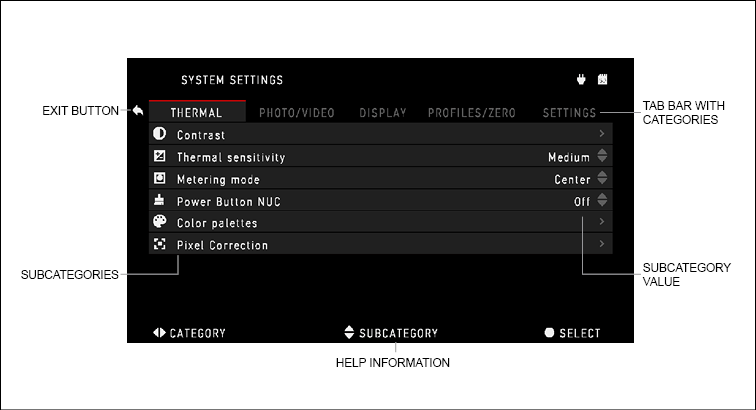
On the left side of the Tab Bar you will find the Exit drop-down (select with arrow icon). Pressing the ENTER button  will bring you back to the Homescreen.
will bring you back to the Homescreen.
Movement between the tabs is carried out using the LEFT and RIGHT buttons  .
.
Each tab includes subcategories. To select a particular subcategory you should use the UP and DOWN buttons  and press ENTER button
and press ENTER button  to select it.
to select it.

To change a particular value:
- Select the subcategory you need by moving the UP or DOWN buttons
 .
. - Press the ENTER button
 to select a particular value, once selected it will turn red.
to select a particular value, once selected it will turn red.
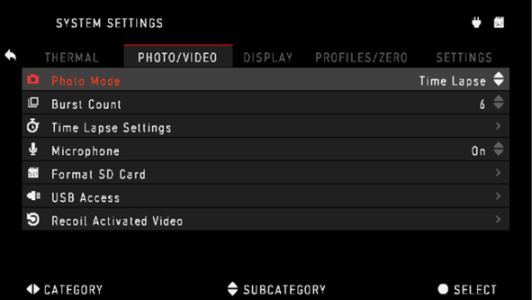
- Change the value with the UP and DOWN buttons
 .
.
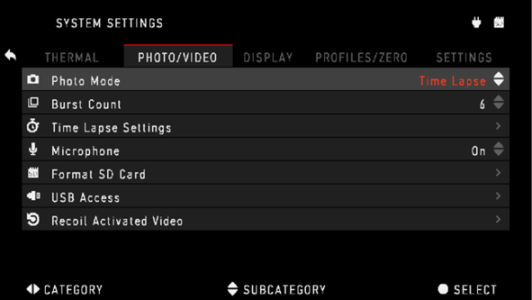
- To select a new value, press the ENTER button
 .
.
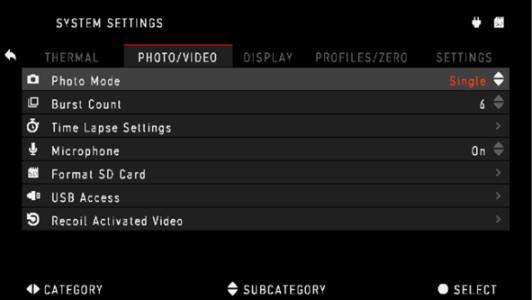
Functions
Photo Modes
From the Homescreen: press the LEFT button  to TAKE A PHOTO. Depending on the selected mode you will make one or several photos. You can choose from the various photo modes in the System Settings.
to TAKE A PHOTO. Depending on the selected mode you will make one or several photos. You can choose from the various photo modes in the System Settings.
NOTE:
You must have a microSD card inserted in the device for these features to work, and all files will be stored on the microSD card.

To enter the System Settings:
- Open Shortcut Carousel with ENTER
 button and select the wrench icon with RIGHT or LEFT buttons
button and select the wrench icon with RIGHT or LEFT buttons  .
. - Push ENTER button
 to enter the menu. Use the Right button till you select Photo/Video tab.
to enter the menu. Use the Right button till you select Photo/Video tab.
NOTE:
There are three photo modes to choose from. Switching between modes is done in the System Settings from Photo/Video tab, subcategory Photo Mode.
- Use UP or DOWN buttons
 to switch between modes.
to switch between modes. - Press the ENTER button
 to select a particular value (once selected it will turn red).
to select a particular value (once selected it will turn red).

NORMAL
This default mode allows you to take one photo at a time.

TIME LAPSE
A sequence of images with an interval of time between each image. The interval and the number of photos taken can be changed in the System Settings.
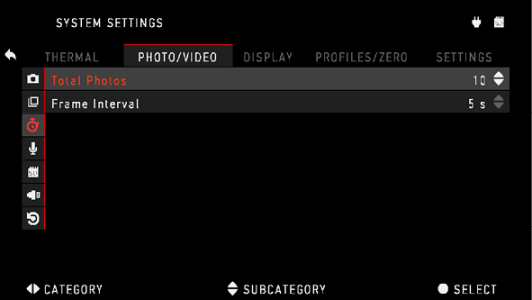
To make changes:
- Choose a Photo/Video Tab in System Settings.
- Use the UP or DOWN buttons
 to select Time Lapse Settings.
to select Time Lapse Settings. - Press the ENTER button
 to enter the mode settings. While you are in this mode, the Time Lapse widget appears.
to enter the mode settings. While you are in this mode, the Time Lapse widget appears.


BURST
Burst mode captures a series of photos. You can select the best image of the group or arrange them in a sequence to study the transitions in detail.
The number of photos taken can be changed in the System Settings. While you are in this mode, the Burst widget appears.

Regardless of the mode you are using, picture preview appears after a photograph is taken. It will appear on the bottom of the screen for several seconds.
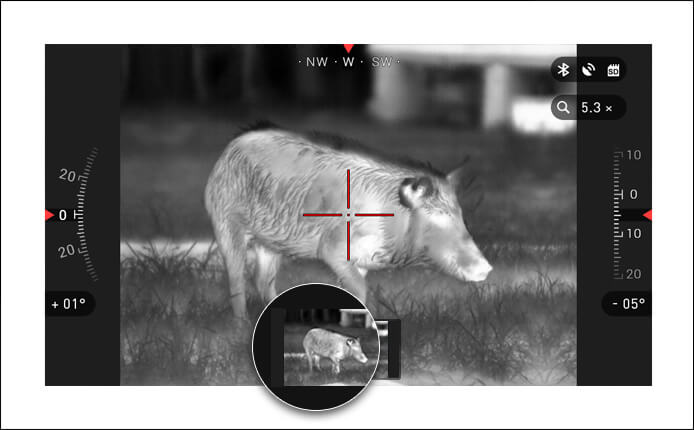
Recoil Activated Video
Recoil Activated Video (patent pending), offers a unique approach to taking videos with your Smart Sight. RAV offers you the ability to take a video before, during and after your shot has been fired. Perfect for those hunting moments when one must concentrate on hitting your target, and not remembering to press the record on your video.
Simply set your RAV to ON, set your parameters and anytime you pull the trigger (RAV is activated from the recoil of your weapon), the sight will record a number of seconds before your shot and a number of seconds after. All conveniently organized as one continuous video.
- Press the RIGHT button
 to Activate RAV from the Homescreen in order to Start Video recording.
to Activate RAV from the Homescreen in order to Start Video recording. - Press RIGHT button
 button again to stop Video recording.
button again to stop Video recording.
NOTE:
It may be best to turn OFF the Microphone in conditions of extreme wind.
- Turn on the microphone and switch the quality of the video in the System Settings (Photo/Video tab).

To enter the System Settings:
- Open Shortcut Carousel with ENTER button
 and select the wrench icon with RIGHT or LEFT buttons
and select the wrench icon with RIGHT or LEFT buttons  .
. - Push ENTER button
 to enter the menu
to enter the menu
NOTE:
You must have a microSD card inserted in the device for these features to work.
- All files will be stored on the microSD card. Recorded videos can be found in the Gallery of the device. The scope allows you to record videos in two modes.

NORMAL
This is the default mode, and the Counter widget and Time Stamp appears when recording.
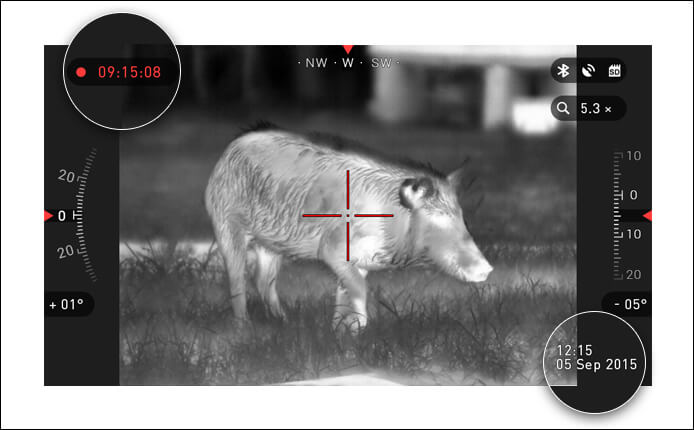
RECOIL ACTIVATED VIDEO (RAV)
When you set your video record to RAV mode (from Shortcut Menu), the system buffers everything your scope sees.
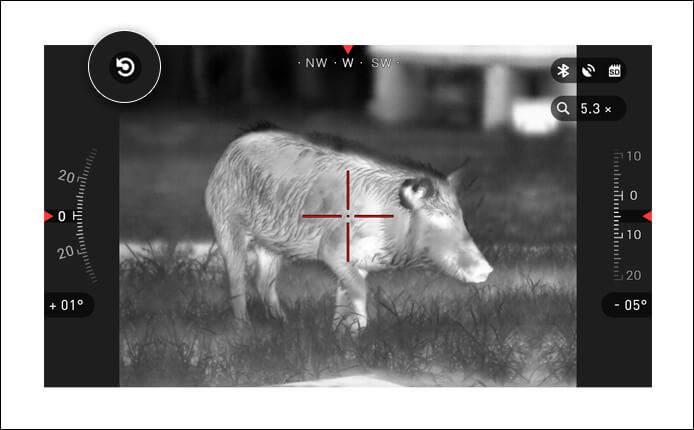
While you are in this mode, the RAV widget appears and then after starting record the Time Counter appears.
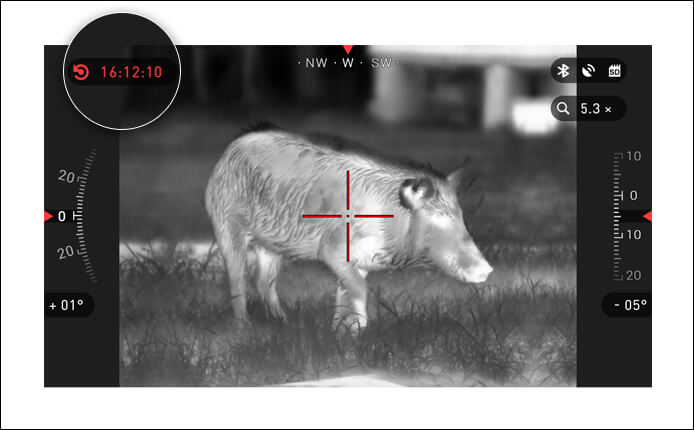
After activating the RAV function in the Shortcut Carousel, return to the Homescreen. Continue the activation process by pressing the Right button to activate the Video. Also, make sure you see the RAV icon on the Homescreens upper left corner.
When a shot is fired, your scope experiences recoil (some airguns may not provide enough recoil for RAV to be activated). The scope will record video prior to the shot being taken, the moment of, and some time after. Exact settings may be adjusted in the System Settings.
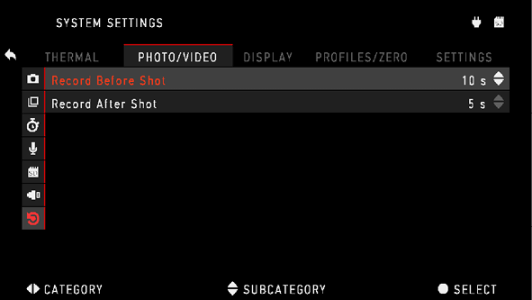
Rangefinder
Using the Smart Rangefinder, you will quickly be able to estimate the distance to your target, as long as you have reasonable knowledge of the size of your target.
NOTE:
Once the distance is measured, the value will be automatically integrated into your Ballistic Calculator.
RANGEFINDER
To use select the Flag Icon from the Shortcut Carousel, press the ENTER button  to take you to the Main Screen of Rangefinder feature.
to take you to the Main Screen of Rangefinder feature.

To measure the distance, follow the next steps:
- put the arrow-mark on the top of the target and press the ENTER button
 , wait for the scope to take the readings (it will take a number of readings so try to keep your weapon steady);
, wait for the scope to take the readings (it will take a number of readings so try to keep your weapon steady);
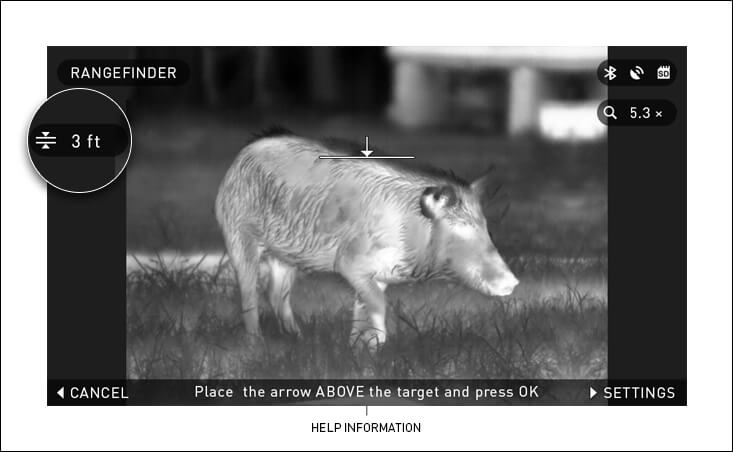
- put the arrow-mark under the target and press the ENTER button
 ;
; - if satisfied with the value, press the LEFT button
 to go back to the Homescreen, or repeat steps 1 and 2 if necessary.
to go back to the Homescreen, or repeat steps 1 and 2 if necessary.

NOTE:
During the measurement process, you can zoom in and out using standard buttons (UP and DOWN).
If the Target Height is incorrect you can change it:
- press the RIGHT button
 to enter the Menu;
to enter the Menu; - сhoose one of the presets or input the height manually;
- accept the height with ENTER button
 and go back to the Main Screen
and go back to the Main Screen
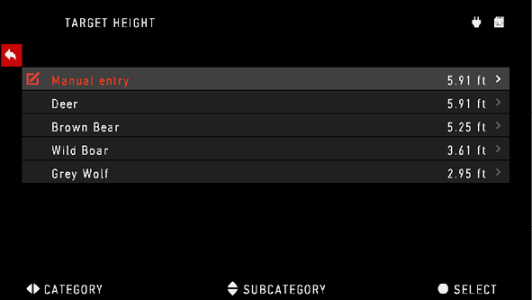
DISTANCE ENTRY
Allows you to input or correct the distance manually. To launch, select from the Shortcuts.
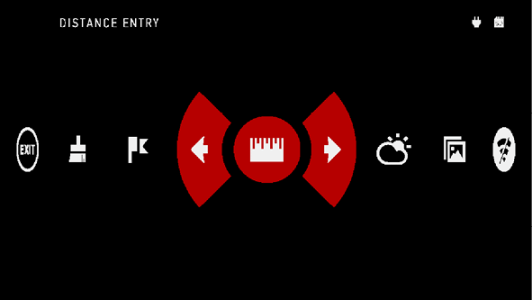
Change distance value using UP and DOWN buttons  . To accept the new distance press ENTER button
. To accept the new distance press ENTER button  .
.
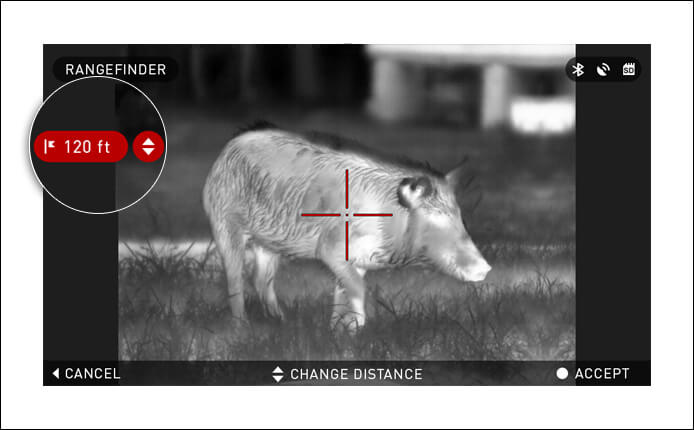
Zeroing
NOTE:
Before zeroing your scope, please make sure the correct lens type is selected. You can check this by going to the System Settings and selecting Settings. You will see the subcategory Device Type. Please make sure you select the lens type of your scope.
This lets the system know which Scope you are actually using (example: ThOR-HD 19 mm or ThOR-HD 50 mm).
To Zero in your scope you will need to go to the Profile/Zero section of the System Settings.

To enter the System Settings you should open Shortcut Carousel with ENTER button  and select the wrench icon with RIGHT or LEFT buttons
and select the wrench icon with RIGHT or LEFT buttons  .
.
Then, push the ENTER button  to access the menu.
to access the menu.
Before you begin the Zeroing process, you will need to either create a new Profile or utilize an existing one. We recommend to create a new one to understand the process better.
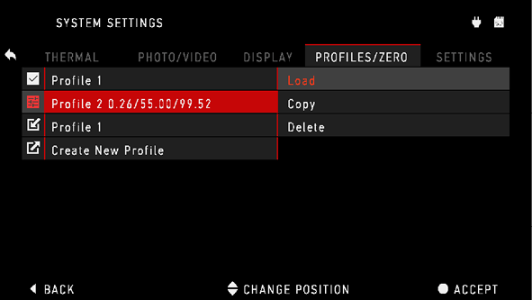
Under the Profiles/Zero Category you will find Current, Other, Import from SD card, and Export to SD card. Select Other. Select Profile 1, Create New Profile, and/or edit/make changes to it. Once you selected a profile, press the ENTER button to load it. Also, your load profile will become your current profile.
Profiles are primarily used in order to utilize your scope on various weapons. This way, when moving your scope from one gun to the next, you can simply select the Profile that you have already created for this gun. Another reason to use multiple profiles is to be able to zero in the scope on the same gun, but at different ranges. For example, one Profile may be called AR 50 yards and another AR 200 yards. This allows you to create two separate profiles to fine tune your shooting solutions for both shorter and longer range shooting.
In order to change the profile name to what you want, download and access the ATN Obsidian app. The app will allow you to connect your Phone/Tablet to your scope.
NOTE:
You will need to obtain a target which thermal is able to see. ATN sells Thermal Targets, or you can use any of the following items: Cold or Hot water bottle, hand warmers, or foil based tape.
To zero your rifle with the ATN device, you should follow the next few steps.
In the System Settings, Select the Profiles/Zero Tab. The main Subcategories of the Profiles/Zero are; Current, Other, Import from SD card, and Export to SD card. Select Current, by pressing the ENTER button  .There you will see Zero Reticle. We suggest you fill out all the ballistic info to the best of your ability before proceeding to Zero. This will save you time when you want to use the Ballistic Calculator at a later time.
.There you will see Zero Reticle. We suggest you fill out all the ballistic info to the best of your ability before proceeding to Zero. This will save you time when you want to use the Ballistic Calculator at a later time.
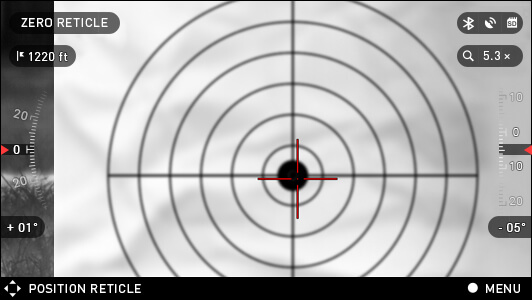
Proceed to Zero the Reticle. Press the ENTER button  to select Zero Reticle. You will see on your screen a cross hair reticle. While keeping the gun as steady as possible, fire a round. Use the key pad to move the Red cross hair to the point of impact, while keeping the White crosshair in the same place you where aiming. Once you have placed the Red crosshair on the POI press the ENTER button
to select Zero Reticle. You will see on your screen a cross hair reticle. While keeping the gun as steady as possible, fire a round. Use the key pad to move the Red cross hair to the point of impact, while keeping the White crosshair in the same place you where aiming. Once you have placed the Red crosshair on the POI press the ENTER button  . A dialogue box will appear with options. Select Save & Exit.
. A dialogue box will appear with options. Select Save & Exit.
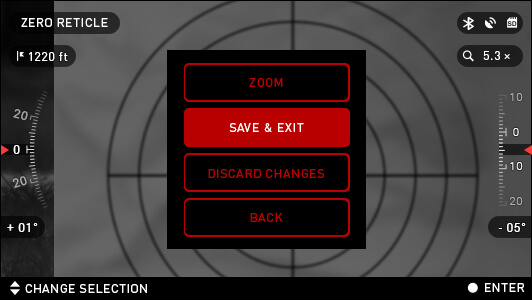
NOTE:
Although you may not need to take more then one shot to zero in your scope, we do recommend that you repeat the process several times to make sure that you truly are zeroed in. As you gain experience in zeroing in your scope, it should take you no time before you are experienced at zeroing out your scope.
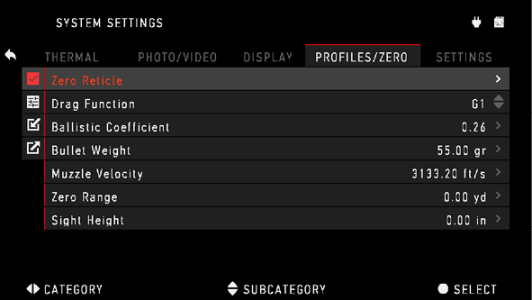
NOTE:
In order to fine tune your zero. Select Zero Reticle once more. Press the ENTER button and select Zoom. Zoom in all the way and fire the weapon. If your POI is not where you had aimed. Move the Red reticle to the POI and Exit & Save. This will insure your POI is the same on optical and maximum magnification.
Ballistic Calculator
The Ballistic Calculator in your scope can seamlessly adjust your point of impact. The first step in utilizing this function requires you to enter all relevant information into the Profile that is being used.
NOTE:
If you do not know all or part this info (example: Initial Velocity) we recommend that you contact the manufacturer of the ammunition and/or the weapon that you are using. Generally this info should be found on the manufacturer’s website.
Once your profile has been setup you are ready to activate the Ballistic Calculator on your sight. Open the Shortcut Carousel and locate the following set of Icons.

You will need to scroll with UP and DOWN buttons  to find the Ballistic Calculator bullseye icon and if it is off (indicated by a diagonal line running through the icon), you will need to turn it on by hitting ENTER button
to find the Ballistic Calculator bullseye icon and if it is off (indicated by a diagonal line running through the icon), you will need to turn it on by hitting ENTER button  while having the icon selected. You will see the diagonal line disappear and a Ballistic Calculator icon will appear in the top right corner of the screen.
while having the icon selected. You will see the diagonal line disappear and a Ballistic Calculator icon will appear in the top right corner of the screen.
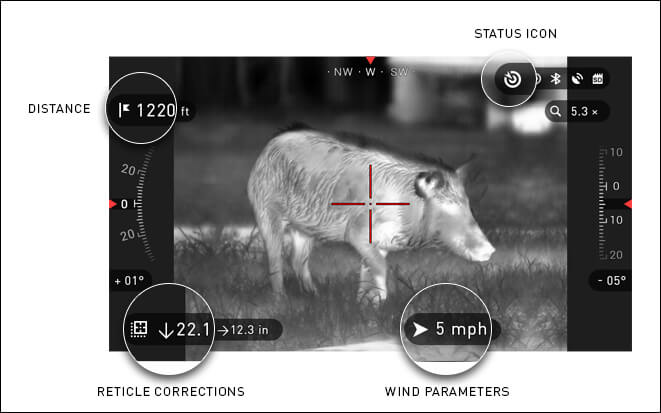
Profiles which are not in use, are situated in the Other section. You can use an existing profile or create up to 6 new user profiles.
To edit a Profile you should select it (highlighted in red), press ENTER button  and choose the action you want to be done: Load, Copy (Duplicate) or Delete the selected profile.
and choose the action you want to be done: Load, Copy (Duplicate) or Delete the selected profile.
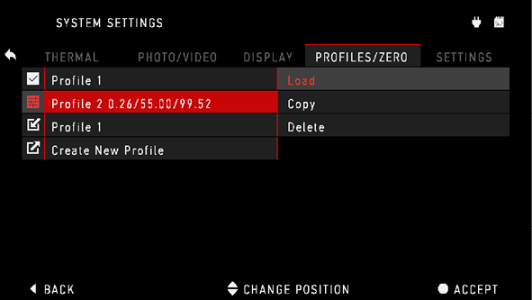
ENVIRONMENT
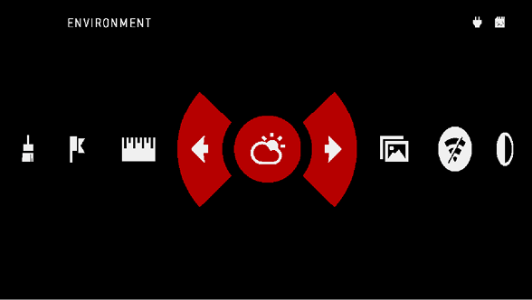
There are a number of Environmental elements that may be entered to increase the precision of your shots.
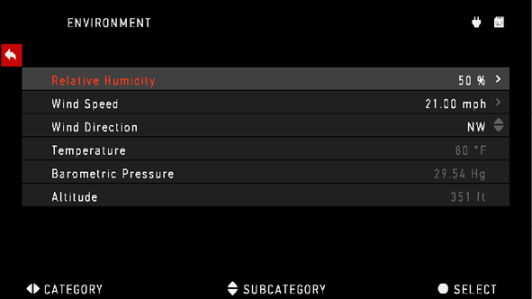
Wind Speed:
Generally speaking, Wind strengths and direction are by far the most important of the group, especially during medium to heavy winds. We highly recommend that if you plan to shoot at ranges of over 300 yards you take wind readings and enter the information into your sight. Both wind speed and wind direction are needed if you plan to make accurate shots. You can enter the information through the Environment shortcut or you can utilize your mobile device (running the Obsidian App with a WiFi connection to your scope), whichever you find easier.
Relative Humidity:
Humidity and Temperature must also be entered through the Environment short cut or by utilizing your mobile device.
Barometer Pressure, Altitude and Temperature:
Both Pressure, Altitude and Temperature will be set automatically using your sight’s internal sensors.
Other Data Collected:
The angle of your scope as in relation to your target is also noted and the Ballistic Calculator takes the information into its calculations.
RANGING IN ON YOUR TARGET
The number one priority to achieve accuracy in long range shooting is to know the range to your target.
The Ballistic Calculator will make your adjustments for you but only after you have entered the range to your target.
Your sight offers several ways to accomplish this task.
RANGEFINDER
Select the Flag Icon from the Shortcut Carousel.
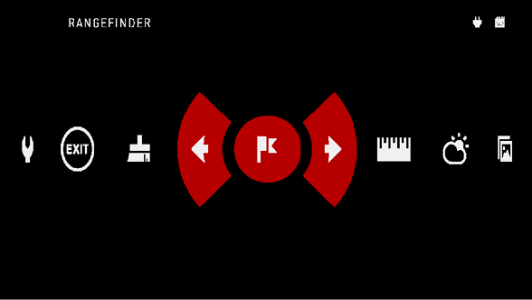
Pressing the ENTER button  will take you to the Main Screen of Rangefinder feature.
will take you to the Main Screen of Rangefinder feature.
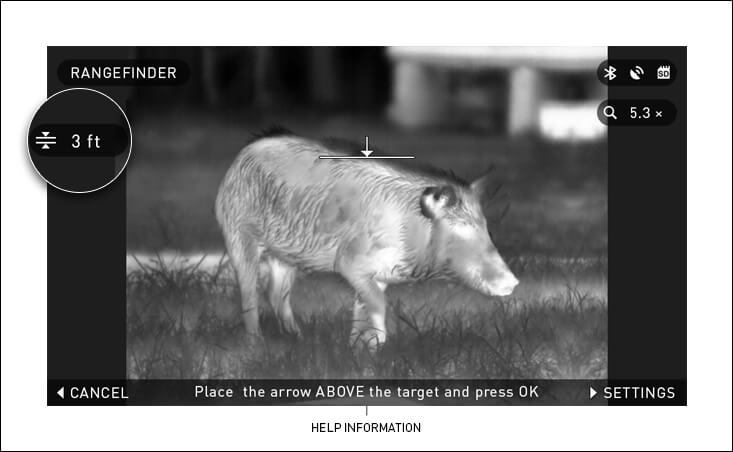
To measure the distance, follow the next steps:
- Put the arrow-mark on the top of the target and press the ENTER button
 , wait for the scope to take the readings (it will take a number of readings so try to keep your weapon steady);
, wait for the scope to take the readings (it will take a number of readings so try to keep your weapon steady); - Put the arrow-mark under the target and press the ENTER button

- If satisfied with the value press the LEFT button
 to go back to the Homescreen or repeat steps 1 and 2, if necessary.
to go back to the Homescreen or repeat steps 1 and 2, if necessary.

NOTE:
During the measurement process, you can zoom in and out using standard buttons (UP and DOWN).
While using Ballistic Calculator your reticle can be displaced from the center point of the screen. Then during Zoom In action it will move to the center.
If the Target Height is incorrect you can change it:
- press the RIGHT button
 to enter the Menu;
to enter the Menu; - choose one of the presets or input the height manually;
- accept the height with ENTER button
 and go back to the Main Screen.
and go back to the Main Screen.
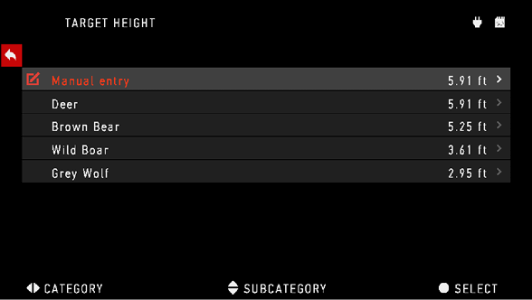
DISTANCE ENTRY
If you are using other means such as a Laser Range Finder you may enter the distance manually using the Distance Entry shortcut.
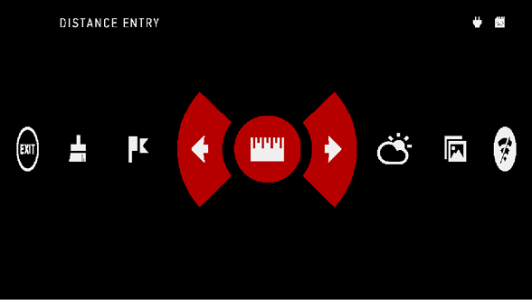
Change distance value using UP and DOWN buttons  . To accept the new distance press ENTER button
. To accept the new distance press ENTER button  .
.
How to perform a NUC
NUC’ing is required to improve image quality when the image is degraded by various environmental factors. There are multiple NUC tables to span the full operating temperature range, and the camera automatically selects the optimum table based on its temperature.
Example: Change of temperature, continues viewing of a particular warm object, movement from one environment to another all may cause image degradation.


To clean up the image you will need to press the NUC from the Shortcut Carousel while closing the objective lens with a solid object (lens cap, hand, book, etc.)
Pixel Correction Procedure
Pixel Correction Procedure is intended to correct “neutral” pixels that are visible in the FOV, but are not responding to the changing environment or scenery. They may be white or black and remain static and or nonresponsive.
- Enter the Carousel by pressing the ENTER button
 .
. - Select System Settings.
- Select Thermal Category.
- Select Pixel Correction Subcategory.
- Select Manual Correction.
- You should see a targeting reticle, use the key pad to move the reticle over the neutral pixel. If it is hard to target the neutral pixel, press the ENTER button
 and select Zoom. Use the UP and DOWN buttons
and select Zoom. Use the UP and DOWN buttons  to zoom in and out on to the neutral pixel in order to isolate it. Once you have isolated the neutral pixel, press the ENTER button
to zoom in and out on to the neutral pixel in order to isolate it. Once you have isolated the neutral pixel, press the ENTER button  to escape from the zoom function.
to escape from the zoom function. - Once the reticle is positioned over the neutral pixel, press the ENTER button
 and select Save. This should correct the pixel.
and select Save. This should correct the pixel.
NOTE:
If after you have done the procedure outlined above and the neutral pixel has not been corrected. Try the process on a pixel directly adjacent to the neutral pixel in order to make a uniformed correction in the FOV.
Reticle Style Adjustment
You can manage reticle style in the System Settings (Display section).
To enter the System Settings you should open Shortcut Carousel with ENTER button  and select the wrench icon with RIGHT or LEFT buttons
and select the wrench icon with RIGHT or LEFT buttons  .
.
Then push ENTER button  to enter the menu.
to enter the menu.
Choose Display in Tab Menu. Movement between the tabs is carried out using the LEFT and RIGHT buttons  .
.
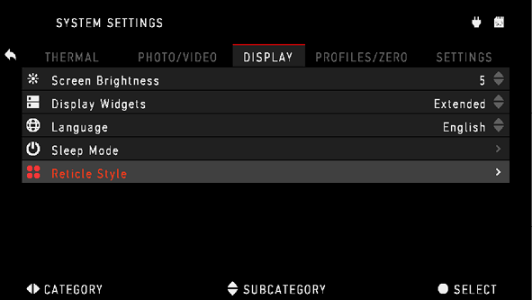
Using the UP or DOWN buttons  select the Reticle Style subcategory. Press the ENTER button
select the Reticle Style subcategory. Press the ENTER button  to select it.
to select it.
To change the Reticle Shape press the ENTER button  .
.
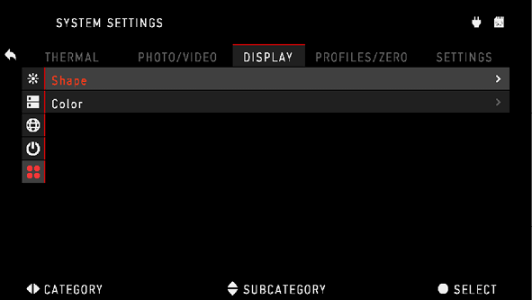
You can select the preferred Reticle style based on your preference. Use the scopes Key Pad arrows to switch between shapes.
To accept the Reticle you want press the ENTER button  .
.
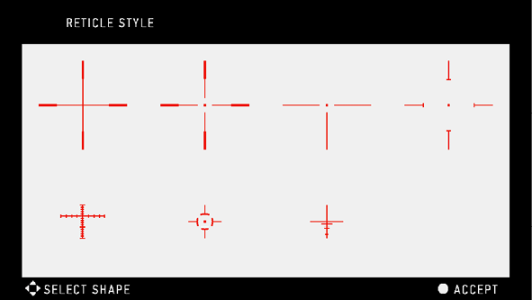
You can change Reticle Color depending on circumstances.
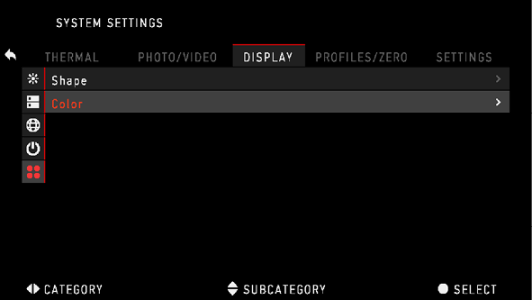
Movement between the colors is carried out using the LEFT and RIGHT buttons  . Then press ENTER button
. Then press ENTER button  to accept your color.
to accept your color.

System Menu
Thermal

CONTRAST —the difference in luminance and color that makes an object more distinguishable. You may adjust the setting from 1 to 5, or select Auto.
THERMAL SENSITIVITY — High, Medium and Low.
METERING MODE — Center of Matrix. Center is when the sensor concentrates on the center of the Thermal Sensor. Matrix is when the Thermals Sensor gathers the thermal info from the entire Thermal Sensor.
POWER BUTTON NUC — On or Off. You can quickly NUC the scope by tapping once on the Power Button.
COLOR PALETTES — This is where you can select White Hot, Black Hot plus other color Palettes.
PIXEL CORRECTION — Is where you can fix neutral none responsive pixels in the FOV.
Photo/Video

PHOTO MODE — includes Single (capture a single photo), Time Lapse (series of photos at timed intervals) and Burst (up to 10 photos in one second) modes.
BURST COUNT — amount of photos in one second (2 – 10). TIME LAPSE SETTINGS
- Total Photos — amount of photos in series (2 – 10).
- Frame Interval — length of the interval (2 – 15 sec).
MICROPHONE — sound recording (ON/OFF).
FORMAT SD CARD — after you choose this subcategory you’ll see a pop-up window asking you about formatting.
RECOIL ACTIVATED VIDEO
- Record Before Shot — the time before pulling the trigger (5 – 30 sec).
- Record After Shot — the time after pulling the trigger (5 – 30 sec).
Display
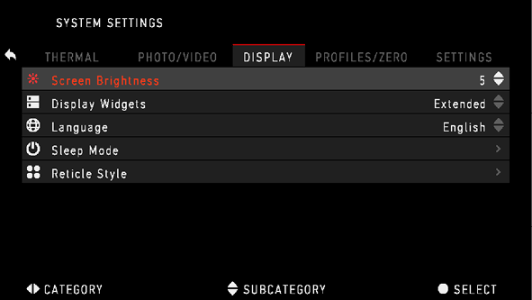
SCREEN BRIGHTNESS — 1-5 with 1 being the dimmest and 5 the brightest. It is recommended that you use the brightest setting during the day for optimal performance.
DISPLAY WIDGETS — allows you to disable several widgets (Minimal/Extended).
LANGUAGE — allows you to select a interface language (English, German, Spanish, Italian, Chinese, Russian, Polish).
SLEEP MODES
Sleep mode is activated when your scope is not in use for a set period of time (example: 1 – 60 min). During sleep mode the display and some of the sensors will be inactive. To get out of Sleep mode and get back to normal operations just physically move the device or press any of the buttons.
NOTE:
Sleep mode can only be activated while the unit contains internal batteries. It can not be activated with using only an external battery pack.
- Mode — allows you to switch the mode (ON/OFF)
- Hibernation Time — can be 1 – 60 min
RETICLE STYLE
- Shape — you can choose the shape of your Reticle.
- Color — you can choose the color of your Reticle.
Profiles/Zero
CURRENT
- Zero Reticle — allows to enter zeroing mode.
- Drag Function — the flight path and characteristics of bullets divided into types (G1 – G8, GL)
- Ballistic Coefficient — measure of bullet’s ability to overcome air resistance in flight.
- Bullet Weight — influences the kinetic energy of the bullet downrange.
- Muzzle Velocity — is the velocity of the projectile as soon as it leaves the barrel.
- Zero Range — is the range that a firearm is sighted at.
- Sight Height — is referring to the distance between the center of the optics and the center of the barrel.
OTHER
- Profile Name — list of existing profiles.
- Create New Profile —allows to create up to 6 profiles.
Settings
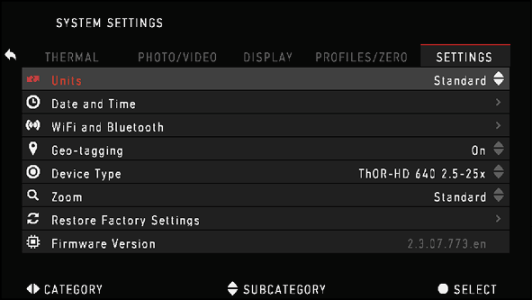
UNITS — can be Metric or Standard system.
DATE AND TIME
- Clock Source — allows you to choose different types of source to improve the accuracy (Manual, WiFi or GPS).
- Date Format — can be YYYY-MM-DD, MM-DD-YYYY, DD-MM-YYYY.
- Time Format — form of stating the time (24-hour or 12-hour).
- Data — enter the date.
- Time — enter the time.
- Time Zone — allows you to choose a geographical region with standard time.
WIFI AND BLUETOOTH
- Remote Controller — Remote Controller (Pair/Unpair)
- Remote Controller Orientation — Wheel Front/Wheel Back
- Rangefinder — Pair/Unpair
Values are not changeable.
- SSID
- Password
- MAC Address
GEO-TAGGING — adding geographical identification to your videos (ON/OFF).
DEVICE TYPE — to make all features work correctly you need to choose the type of lens system you have.
ZOOM — allows you to choose different types of zoom (Standard, Extended). Extended Zoom will give an electronic zoom of 10x your optical Zoom.
Example: 3–14x in Extended mode becomes 3–30x. However, we would like to caution you that you will begin to see considerable pixelation at such a zoom.
RESTORE FACTORY SETTINGS — allows to reset all the settings to default.
FIRMWARE VERSION — allows you to see the firmware version currently running on your sight.
We recommend that you register your product on our home page (www.atncorp.com) in order to make sure that you are getting emails when new firmware versions become available.
We are constantly working on new features, functions, and improvements that we provide to you free of charge via firmware upgrades.
Servicing
Cleaning eyepiece
Over time debris or dust particles may find themselves on the micro display in your eyepiece.
Please follow the following instructions to remove the debris:
- Remove the Eyepiece — by first loosening the two Set Screws that hold the Eyepiece in place (you will need a 1.5 mm hex key). Then unscrew the eyepiece and remove it entirely. Once the set screws have been loosened the eyepiece should be relatively easy to unscrew, do not use excessive force.
- To clean the Micro Display — we recommend using a compressed air canister. Just blow the air all around the micro display and then blow the air on the display itself. The plastic screen covering the display will bend under the air pressure and will allow burst of air inside of the micro display housing.
- Reinstall Eyepiece — check if all debris have disappeared from your view. If more debris remain Repeat Step 1 and Step 2. Do not forget to re-tighten the Set Screws after completing your cleaning.
Warnings and Сautions
- Always remember to turn off the device when it is not in use. If you do not plan on using it for a period of more than 10 days, you should remove the batteries.
- Do not disassemble, drop, open, crush, bend, deform, puncture, shred, microwave, incinerate, paint or insert foreign objects: it will void your warranty.
- Keep lens cap on when not in use.
- Avoid contact with dust, steam, and gas.
- This product contains natural rubber latex which may cause allergic reactions.
- The scope is a precision electro-optical instrument and must be handled carefully.
- Do not scratch the external lens surfaces or touch them with your fingers.
CAUTION:
Failure to follow these safety instructions could result in damage to the device!
Mobile Applications
By utilizing the  ATN Obsidian app, you can control your device and view live streaming. Connect a phone or tablet and view everything simultaneously.
ATN Obsidian app, you can control your device and view live streaming. Connect a phone or tablet and view everything simultaneously.
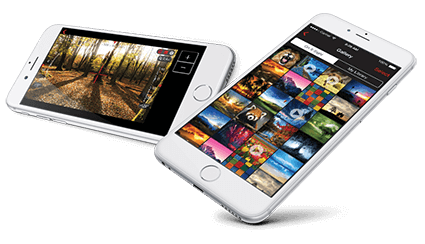
Want to see what you’ve recorded so far? No problem, once connected to the app via WiFi, open up the Gallery and playback your latest adventures. All your photos and videos are right at your fingertips. In order to download the latest version of the ATN Obsidian App. Please visit the iOS store or Google Play store. Search for “ATN Obsidian” install the application.
Make sure to enable WiFi on your Device in the Shortcut Carousel.
Make sure your smart phone or tablet is not connected to any other WiFi connection. In your smart phone/tablet go to your WiFi connections and select SSID for example (DeviceName_XXXX). Password is “atn_obsidian”. Once you connect to your device with your smart phone/tablet. Open the application. You should see the device which you are connected to in the app. Select the Device Name. This will allow you to control your ATN device with your smart phone/tablet.
